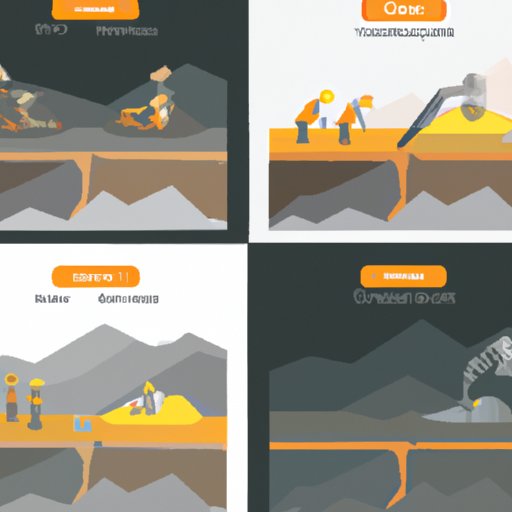Introduction
Minerals and rocks are two of the most important components of the earth’s crust. They form the basis of many geological processes, such as the formation of mountains, valleys, and other landforms. The study of minerals and rocks is known as mineralogy, and it has been used for centuries to identify and classify different types of rocks and minerals. In this article, we will explore the different types of minerals and rocks, their characteristics, how they form, and their role in human health and well-being.
An Overview of Minerals and Rocks: Exploring the Different Types and Their Characteristics
Minerals are naturally occurring substances found in the Earth’s crust. They have a definite chemical composition and physical structure and are typically formed by geological processes such as crystallization, precipitation, or evaporation. There are more than 4,000 known minerals, and they are divided into two main categories: native elements and compounds.
Native elements are minerals composed of one element only, such as gold, silver, and copper. Compounds are minerals composed of two or more elements, such as quartz, feldspar, and mica. Minerals can also be classified according to their crystal structure, hardness, color, luster, streak, cleavage, and fracture.
Rocks, on the other hand, are composed of one or more minerals. They are typically formed through the process of lithification, which involves the compaction and cementation of sedimentary particles. Rocks can be classified according to their texture, composition, and origin. The three main types of rocks are igneous, sedimentary, and metamorphic rocks.
How Do Minerals Form? Examining the Process of Mineralization
Minerals form through a variety of geological processes. The most common process is crystallization, which occurs when molten rock cools and solidifies. This process forms crystals of different shapes and sizes, depending on the type of mineral. Other processes that form minerals include precipitation, evaporation, hydrothermal alteration, and biological processes.
Mineral deposits are formed when minerals are concentrated in certain areas due to geological processes. These deposits can be classified according to their origin and composition. Placer deposits are formed by the erosion and redeposition of minerals by water, while vein deposits are formed when minerals precipitate from hot, pressurized fluids. Other types of deposits include contact deposits, pegmatites, and hydrothermal deposits.
A Geologist’s Guide to Identifying Rocks and Minerals
It is important to understand the differences between rocks and minerals. Rocks are composed of one or more minerals and are classified according to their texture, composition, and origin. Minerals, on the other hand, are naturally occurring substances with a definite chemical composition and physical structure. Identification of rocks and minerals is an important part of geology, and there are several methods used to identify them.
The most common method is visual inspection, which involves examining the size, shape, color, and texture of the specimen. Other methods include chemical analysis, X-ray diffraction, and optical microscopy. Identification of minerals is also aided by the use of field guides, which provide photographs and descriptions of different minerals.

Mining for Minerals: The Pros and Cons of Extracting Natural Resources
Mining is the process of extracting minerals from the earth’s surface. It is an important economic activity and provides many jobs in the mining industry. However, mining can also have negative impacts on the environment, including pollution, destruction of habitats, and depletion of natural resources. Therefore, it is important to consider the pros and cons of mining before undertaking any activity.
In order to reduce the negative impacts of mining, governments have implemented regulations and safety measures. These include the establishment of environmental protection laws, the enforcement of safety standards, and the monitoring of mining activities. Additionally, organizations such as the United Nations Environmental Program (UNEP) have developed guidelines to ensure responsible mining practices.
Exploring the Role of Minerals in Human Health and Well-being
Minerals play an important role in human health and well-being. They are essential nutrients that help maintain the body’s balance of electrolytes, hormones, and enzymes. Examples of minerals used in health supplements include calcium, magnesium, iron, zinc, and selenium. Additionally, minerals such as copper and manganese are important for bone health, while chromium helps regulate blood sugar levels.
Minerals can also be found in food sources, and it is important to consume a balanced diet in order to get all the necessary nutrients. Foods that are rich in minerals include nuts and seeds, leafy greens, legumes, and whole grains. Additionally, drinking plenty of water can help the body absorb minerals more efficiently.
Conclusion
Minerals and rocks are essential components of the earth’s crust and play an important role in many geological processes. In this article, we explored the different types of minerals and rocks, their characteristics, how they form, and their role in human health and well-being. We also discussed the pros and cons of mining and the importance of consuming a balanced diet in order to get all the necessary nutrients.
Further research is needed to better understand the complexity of minerals and rocks, their formation processes, and their impact on the environment and human health. Additionally, research should focus on developing more efficient methods of extraction and refining minerals to reduce the environmental impacts of mining.
(Note: Is this article not meeting your expectations? Do you have knowledge or insights to share? Unlock new opportunities and expand your reach by joining our authors team. Click Registration to join us and share your expertise with our readers.)
